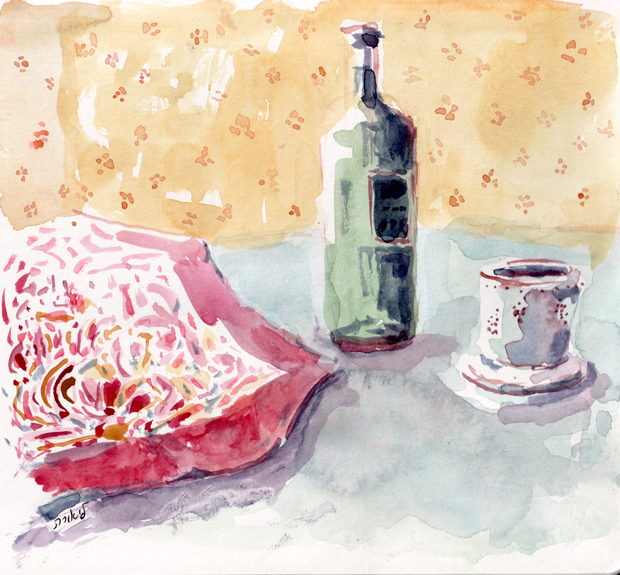
I find I often paint in themes. On Fridays, I am often inspired to paint a shabbat table scene or my candles. However, I rarely have time on Fridays.
Those who do not keep the Sabbath might ask: how do you tolerate a day without being able to paint or draw? My response: as long as I have time during the week for painting or drawing, the Sabbath is a welcome day for reflecting. I do not record every minute of my life what transpires. Having time just to sit and think helps one when life is rushed during the week.
In the Torah the Sabbath is mentioned many times. One example is in the parsha of Kedoshim 19:3 where it says: “you shall observe My Sabbaths.”

Late Friday afternoon one hour before sunset I light the candles for Shabbat. It is a time of reflection and meditation. No more rushing about. The food is cooked. One says the prayer and takes time to move one to whatever is next.

I really like painting green wine bottles. It has reflection and a deep green color. It reminds me of family members who enjoy visiting vineyards and tasting good wine. As a painter who likes to capture the light, the bottle is elegant and slender and says: “use me as your prop.”
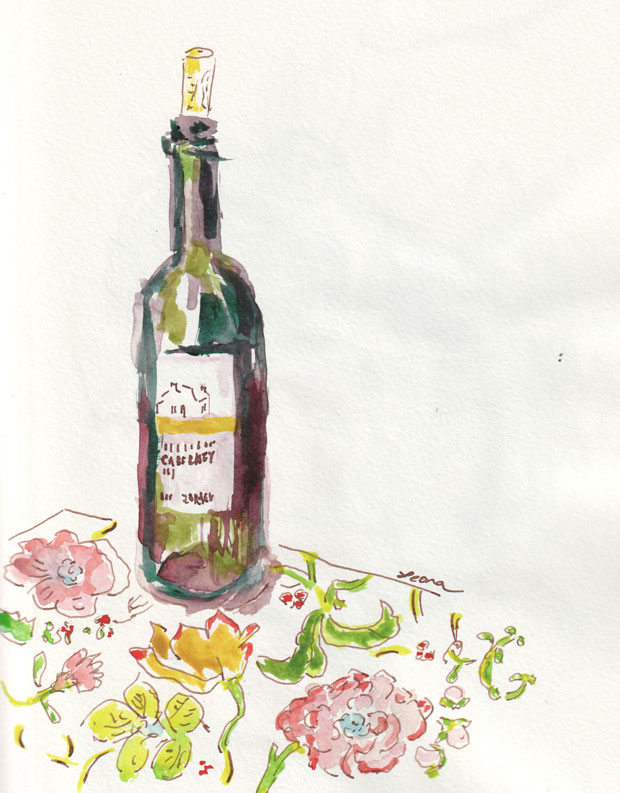
This is one of my favorite wine bottle paintings. I like the paisley fabric upon which it rests. A good combination for a still-life.
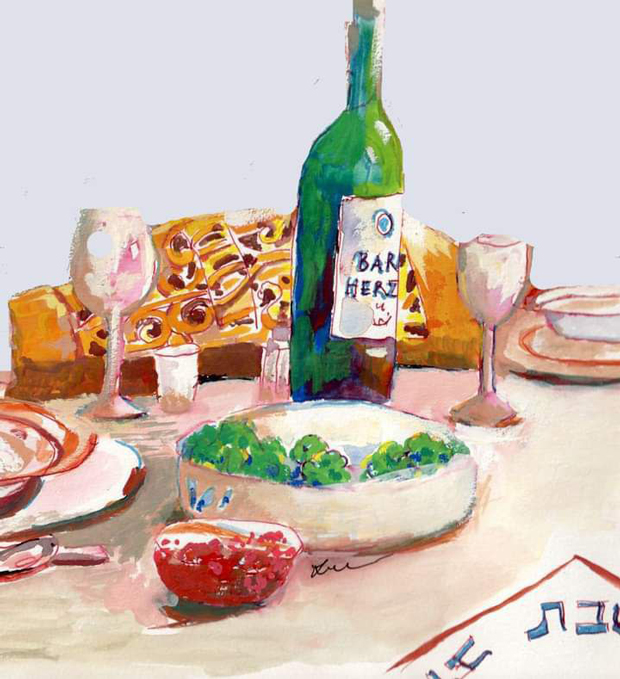
This Shabbat table setting, painted in gouache, reflects some of our busy meals. I make a variety of foods, put on several colored tiles like the one that appears in the corner, and use my good china. I like how the salt shaker, an important item as it gets sprinkled on the challah after the blessing, peaks out from behind the tall wine bottle.
If you want to purchase a print of any of these Shabbat scenes, visit my store for more information.
In the winter there is less opportunity to paint or draw on site. I use the time as an opportunity to improve paint technique and use photos or drawings of masters to inspire my artwork. I continue to work on a parsha (Torah portion) image each week. Lately, a few of my favorites have been birds or animals. Also, I joined a group on Facebook which offers prompts for each day. Not every prompt inspires me to paint or draw. But several have, and some of the better ones I will post on my blog or on the art database.
I do not have any pets currently; however, we do have a bird feeder outside our kitchen window. One of the prompts was bird on a wire. I like the idea of drawing directly from nature, but birds are too fast! It is hard to photograph them; you can see some of my past cardinal photos on this blog.
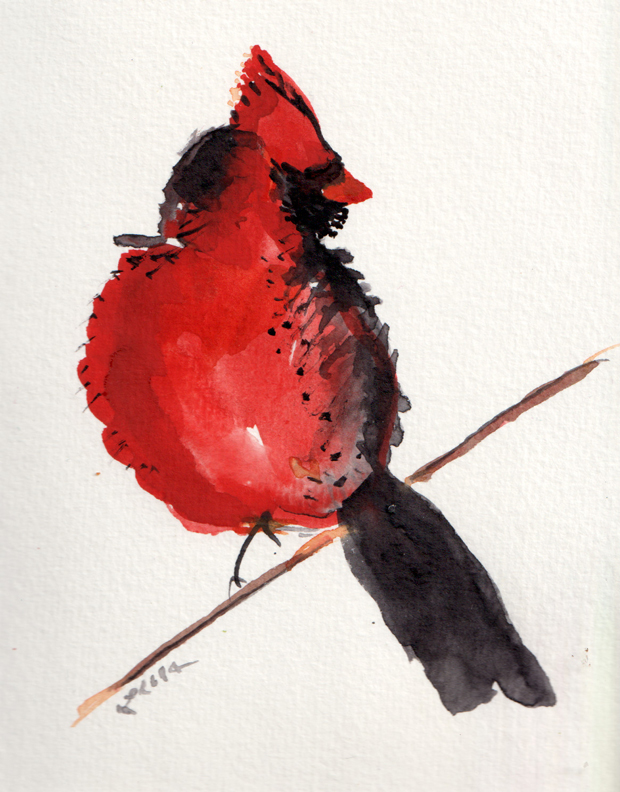
I painted this flaming red male cardinal from one of my photos when the prompt was Bird on a Wire.
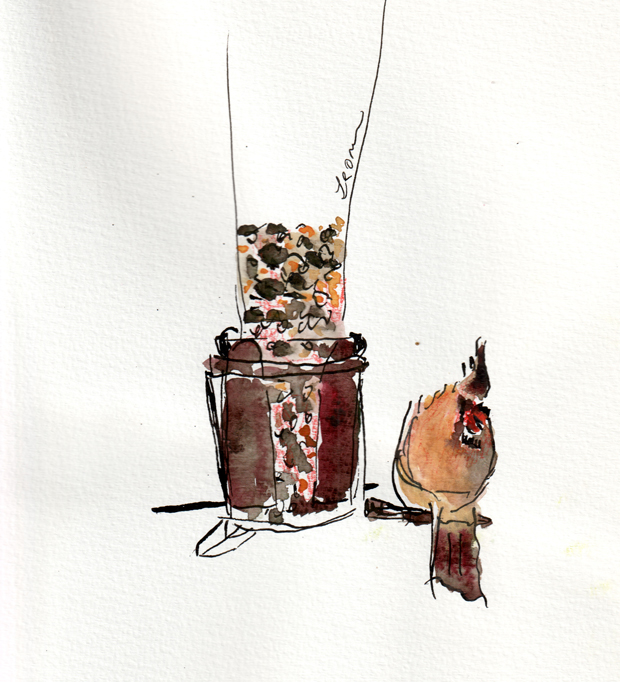
I drew and painted (watercolor, ink, and Derwent Inktense colored pencil on paper) this lady cardinal at a bird feeder in honor of parshat Beshalach, when there is a custom to feed the birds.
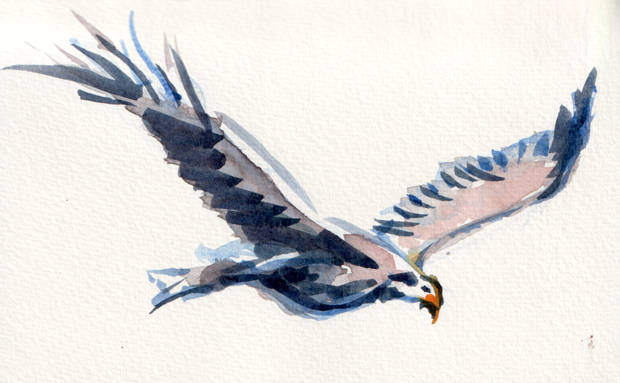
The next week was Parshat Yitro with the quote: And I bore you on eagles’ wings (Exodus 19:4). One eagle is just watercolor on the white of the paper.
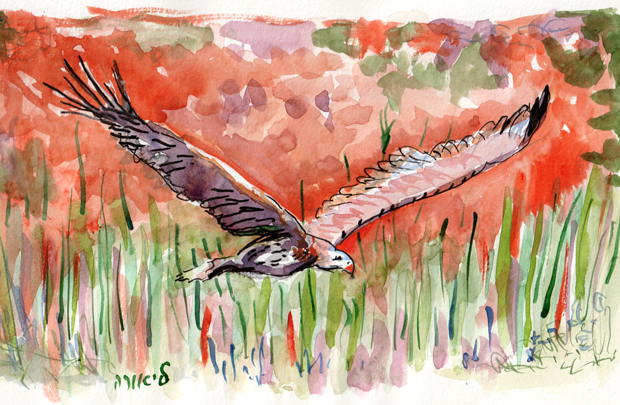
I also did an eagle with an orangey-red background. It came so orange that one friend thought the background was fire. She interpreted it as Israel on fire, and the eagle (perhaps God?) comes to our rescue.
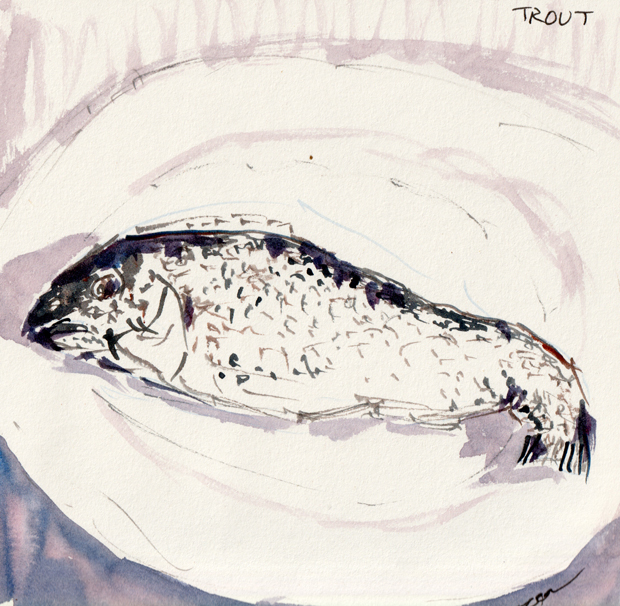
There was a prompt for fish. I painted the trout we had for dinner. Yes, that is all watercolor.
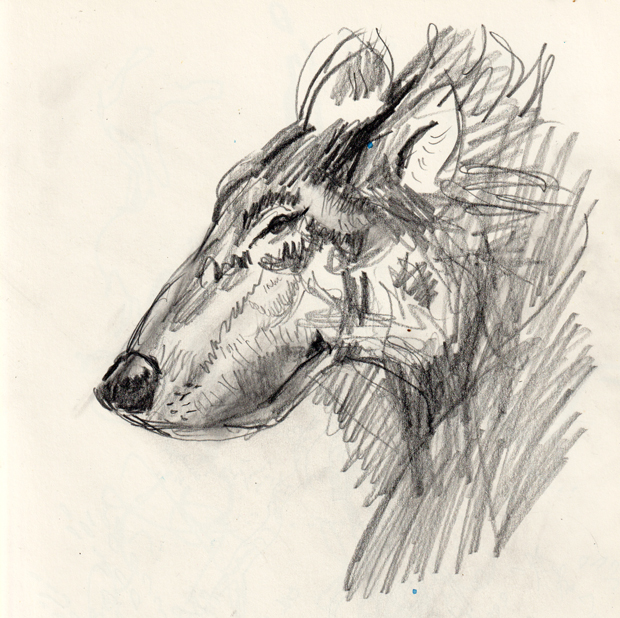
I will conclude with this pencil drawing of a wolf (copy of a drawing by Victor Ambrus), executed for parshat Vayechi 49:7.
Benjamin is a ravenous wolf;
In the morning he consumes the foe,
And in the evening he divides the spoil.”
בִּנְיָמִין֙ זְאֵ֣ב יִטְרָ֔ף בַּבֹּ֖קֶר יֹ֣אכַל עַ֑ד וְלָעֶ֖רֶב יְחַלֵּ֥ק שָׁלָֽל׃
Unlike summer for the rest of the world, summer in the Jewish calendar is a time of sadness. In the month of Tammuz, we remember the siege of Jerusalem. In the month of Av, we mourn the holy Temple, the Bait HaMikdash, that was destroyed not just once but twice. There is a custom not to listen to music during the three weeks between the 17th of Tammuz (siege of Jerusalem) and the 9th of Av (destruction of the Temple).
Painting Music
By the 15th of Av, however, the sadness turns to joy. One of the ways humans experience joy is listening to music. I was fortunate to attend not one concert but two concerts around that time. Rugburn, a band that plays jazz, funk, and rock music, held a concert in local Donaldson Park, so I had a great time not just drawing the musicians’ movements but also adding in the surroundings. The Imperial Band of South River plays pop and classical music in the Imperial Music Center of South River; a friend plays with the Imperial Band each month, and I finally had a chance to attend, drawing pad and Uniball pen in hand.
For both concerts I took my drawing notebook. I did quite a few drawings of the musicians. In fact, I paid more attention to the bodily swaying of the musicians that I did the notes that came out of the musical instruments.

My favorite from Rugburn is this one with the four players swaying to the music and the beautiful reeds and grasses of Donaldson Park swaying in a variety of colors in the background.
You can see more in the art database: https://www.leoraw.com/artcat/rugburn/
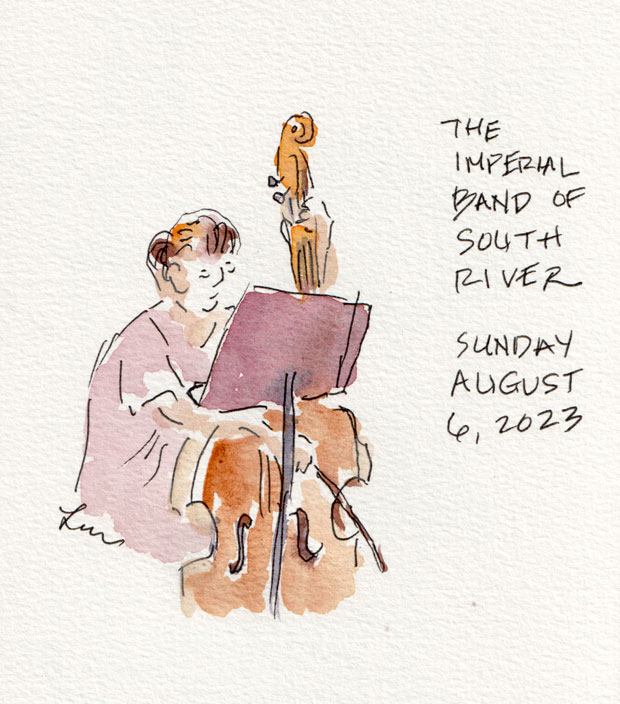
I really like the bass player from the Imperial Band. You can see more of the Imperial Band in the art database.
Preparing for Yom Tov

So far, most of my preparation for Yom Tov (holidays) is in my head. I plan to do a Rosh Hashana dinner with as many simanim as I can prepare. Above is a painting of Dates in Front of Palm Tree, watercolor on paper, 2011. Maybe next week I will do a painting of Elul, the Jewish month before Rosh Hashana, which is a time of preparation and asking for forgiveness.
An Art Database
One of the reasons I created an art database is so when potential clients can ask: what works can I buy as prints? I can point to the art database or to a specific category such as Raritan Avenue.
I placed my first order of giclée prints for a client this past week. Giclée is the recommended way to produce archival reproductions of fine art. She had saved screenshots of her favorites my work from the past few years. In the future, I will say to a client: browse through the art database! That’s where one can find illustrations that will work well as prints.

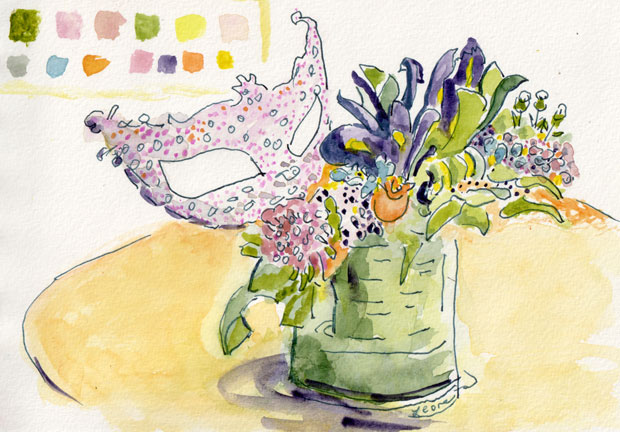
I painted the bouquet of flowers (note the purple irises and the mask) that I bought from Roberts Florals in Highland Park, New Jersey on Purim. My guests enjoyed the bouquet along with the meal. I am relatively pleased with the result of the painting.
My current ultimate goal is to get better at painting portraits. I am confident in my flower painting abilities. I could improve in details, but I do not strive to be a realistic floral artist. One reason I chose to paint the bouquet is it was a good warm up to painting after Shabbat and after a week of little painting in general.
Why I failed miserably at 100 people week
Early in March there was a competition to draw or paint 100 people in a week. My start was delayed by Purim; I had lots of preparations to do for the holiday, and guests showed up to entertain us at our seudah (festive meal). Finally, I went out one day with my sketchpad and doodled quite a few people. I did not care much for the result, so it is not getting posted here. Then I ran out of time to go outside and look for people. So I went up to my attic late one night, and I took down several photos of people that I found inspirational.
How 100 people week Inspired Portraiture Adventures
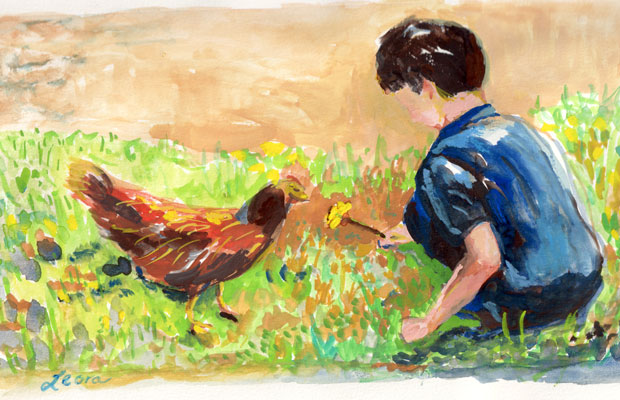
One of the photos that I found was one of my sons showing a dandelion to a chicken. I did one quick sketch; the proportions of the head were off. I started another. I continued painting into the night, and I am please with the result: gouache media, lots of strokes and movement. I like how the light falls on the figures and the variety of hues established.
Here is another portrait that I did, from an old black and white photo of a relative eating soup. This portrait is also done with gouache. Maybe I will do another version in the future with more attention to the background.
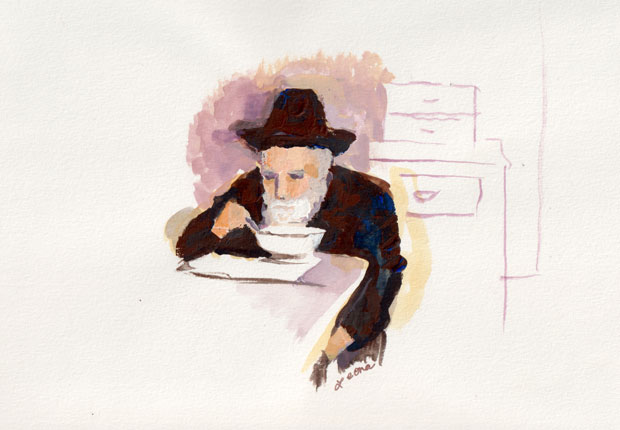
More Flowers to Show
Whenever I go shopping with a certain friend, I am done long before she is. No problem! Each store seems to have a section of flowers. So I put my paid groceries in the car, and I return to draw with a Uniball pen whatever strikes me in the store. Often, the flowers stand out. Here are a few of my favorites:
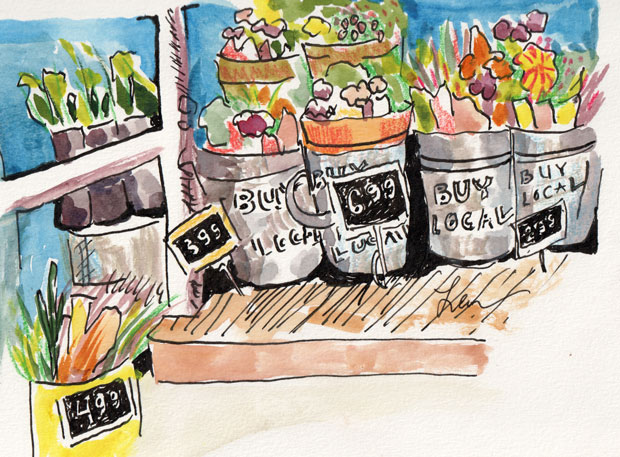
This one was painted after another one that had the brand name of a large chain store got rejected from an online shop that sells artists’ goods. Lesson learned: buy local flowers. Advertise local stores. No need to ruffle the feathers of any large chain stores.
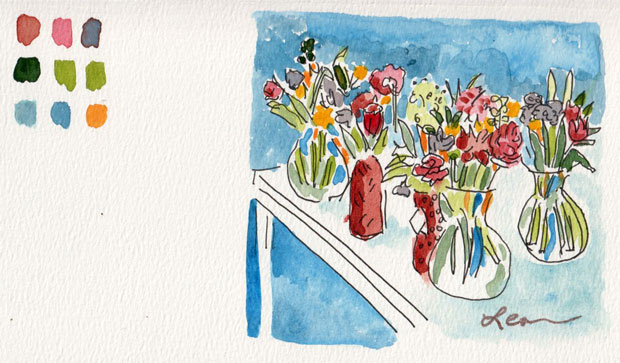
I often like painting a palette of colors near my watercolors. This palette compliments the flowers nicely, organic flowers shapes near geometric squares.
More on Painting Flowers
I am reading Painting Flowers in Watercolor with Charles Reid, a classic in the watercolor book world. Two ideas that I look forward to incorporating in future watercolor floral sketches or paintings:
1) Pay attention to negative shapes that the flowers make almost as much as to the flowers themselves. Do not overwork the details. Paint the background along with painting the flowers. The background should not be an after thought.
2) When painting the background, don’t do one solid expanse of one color. Do a variety of color in a mix that compliments whatever flowers one is painting.
Charles Reid uses a lot of cadmiums in his palette (Cadmium Yellow, Cadmium Orange). I will substitute colors in my palette, probably Hansa Yellow (light, medium, or dark) and New Gamboge. One exercise is to paint daffodils. Another is techniques for white flowers. Daffodils and magnolias are in bloom now. Hopefully, I will be able to experiment with his ideas.
It is now the Jewish month of Nissan. In Nissan we celebrate freedom on Passover. We are also commanded to say blessing on a fruit tree when it shows its first blossoms. I will be looking around my neighborhood for all kinds of blossoms for blessings and for sketches.

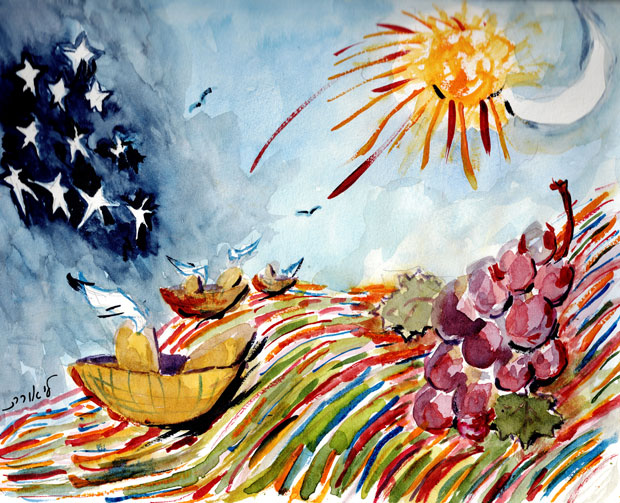
I succeeded in making illustrations for each of the parshiot (section of Torah read in the synagogue each week) of Breishit (Genesis) this past fall. However, only a few illustrations became blog posts.
I had a great time redoing an illustration for Parshat Vayeshev, the parsha that has Joseph’s dreams along with the dreams of the butler/cupbearer and of the baker.
“I have had another dream: And this time, the sun, the moon, and eleven stars were bowing down to me.” — Genesis 37:9
On the vine were three branches. It had barely budded, when out came its blossoms and its clusters ripened into grapes. — Genesis 40:10
In the uppermost basket were all kinds of food for Pharaoh that a baker prepares; and the birds were eating it out of the basket above my head.” — Genesis 40:17
The stripes of Joseph’s coat, not part of a dream but part of the parsha, felt like I was painting a roller coaster.
Jacob’s Ladder, a work on paper done in gouache, is one of my favorites. In creating the painting Jacob’s Ladder, story found in Parshat Vayeitze, I looked at Renaissance and more recent paintings for inspiration. The man lying down was actually inspired by a relative napping on a couch. He made a convenient model for the painting.
He had a dream; a stairway was set on the ground and its top reached to the sky, and angels of God were going up and down on it. — Genesis 28:12-13
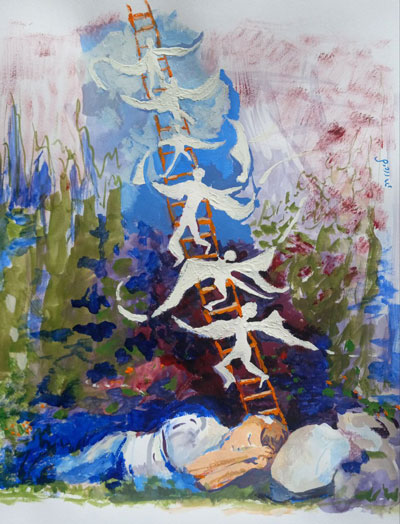
I set up a store so I can sell reproductions of my art work. There are two options: for those who want fine art productions they can hang proudly in their homes, I am offering prints of painting such as Jacob’s Ladder and Joseph’s Dreams for limited times with limited prints. One will need to contact me directly to get a fine print. For those who like mugs or tote bags with Highland Park illustrations, visit the online shop (click on any image to get to more products). Buy as many of those as you want!


One of my problems with blogging is coming up with text. When I used to use SEO tools (search engine optimization), they would say “you need 500 words or so to be” blah blah blah, something about meriting a golden spot in some grandstanding search engine. Well, if words are needed, here are some words.
A new year begins … we ended the fall holidays of Rosh Hashana, Yom Kippur, Sukkot, Shemini Atzeret, and Simhat Torah. The Jewish year of 5783 has begun. I am hoping to do a little more blogging this fall … Learn How to Ferment (or whatever I will choose to name the post) is almost for publishing. Other blog ideas: How to See In Order to Draw Better. Highland Park Synagogues in Watercolor or Gouache. Highland Park Restaurants. Local Park Scenes. Not all of these will make it to production … but maybe one or two will.
Each week I aim to make an illustration for the parsha (portion of the Torah read in the synagogue on a weekly basis). For Breishit, the first parsha of the year I depicted (Genesis 2:20):
And Adam gave names to all the cattle and to the birds of the sky and to all the wild beasts;
וַיִּקְרָ֨א הָֽאָדָ֜ם שֵׁמ֗וֹת לְכׇל־הַבְּהֵמָה֙ וּלְע֣וֹף הַשָּׁמַ֔יִם וּלְכֹ֖ל חַיַּ֣ת הַשָּׂדֶ֑ה
Why did I choose the pasuk (sentence) about Adam naming the animals? I just liked the idea Adam gave out names. It was opportunity to draw an elephant. Except the elephant did not make it into the finished illustration. Lion is King of the Forest. So Lion is on top. Eagle is a majestic bird, so it got the bird spot. And bulldogs are cute.

After Breishit, the parsha is Noah. I get a little help each week from Rabbi Avigdor Bonchek, author of the What’s Bothering Rashi series.
I chose to illustrate the dove in the story of Noah because of a Rashi about this pasuk (sentence) (Genesis 8:8):
וַיְשַׁלַּ֥ח אֶת־הַיּוֹנָ֖ה מֵאִתּ֑וֹ לִרְאוֹת֙ הֲקַ֣לּוּ הַמַּ֔יִם מֵעַ֖ל פְּנֵ֥י הָֽאֲדָמָֽה׃
Then he sent out the dove to see whether the waters had decreased from the surface of the ground.
Who was supposed to see if the waters had subsided? Noah or the dove? It was Noah. If the dove did not come back, then there was land for the dove. If she found a resting place, the yonah (dove) would not return.
Before the dove, Noah sent out a raven. Maybe next year I will paint a raven.

What is the motivation to choose a subject to paint? Why pick one object over another? Why would someone paint a particular person? I think the answer to all of these questions is emotional attachment. If you feel good or expect good feelings from painting a chosen object or person, you are more likely to enjoy the painting process and not feel like it is a task.
Why did I enjoy painting this wine bottle? I liked the looseness that I applied to the bottle. I also had fun with the patterned fabric underneath it.

A few weeks later, I painted these books on the same patterned fabric. It was in response to the theme of PATTERNS, an instagram challenge. I was able to pay careful attention to the details in part because I knew people on Instagram would be looking at the painting. I have emotional attachment to the fabric, as it was a purchase by my mother z”l.
The book of Illustrated Tehillim was given to me by my mother-in-law, as she knew I was looking for pictures of tehillim. Lamentations, the English name for the megillah of Eicha, is a book I am reading by Yael Ziegler, a wonderful speaker who I have met in person. Read it if you want a detailed, scholarly, and poetic approach to reading Eicha. I did this painting right after Tisha B’Av, the week we read parshat Nachamu, about comfort (Isaiah 40:1):
נַחֲמ֥וּ נַחֲמ֖וּ עַמִּ֑י יֹאמַ֖ר אֱלֹֽהֵיכֶֽם׃
Comfort, oh comfort My people,
Says your God.
Those books rest under Devarim, the parshiot we are reading now at this time of the summer.

Tisha B’Av (9th of the month of Av) is the saddest day of the Jewish calendar. It occurs in the summer, sometimes in July, sometimes in August. This year it occurs on Sunday, August 7. I wanted to portray an upbeat story but still connect with the sadness. There is a famous story told at the end of the gemara of Makkot about Rabbi Akiva and a fox. The Beit HaMikdash (Holy Temple) was destroyed on Tisha B’Av. However, when it happened, Rabbi Akiva laughed. He laughed because he saw a fox coming out of the ruins.
When they arrived at the Temple Mount, they saw a fox that emerged from the site of the Holy of Holies. They began weeping, and Rabbi Akiva was lauging. Why are you laughing, Rabbi Akiva? … the prophecy of Uriah was fulfilled, it is evident the prophecy of Zechariah remains valid. Akiva, you have comforted us. Makkot 24B
I painted the Fox in Ruins once before, back in 2011. That one had a little Maccabee beer can, as I had been in the Old City of Jerusalem and was dismayed to see litter. I skipped the beer can in my 2022 version and emphasized the text of the Makkot gemara story.
My brand new Derwent Inktense watercolor pencils arrived just when I was finishing up this watercolor. So I added a bit of watercolor pencil to the underside of the fox.

Why is Purim theatrical? To learn about the hidden Purimspiel (Purim play), visit Bubby’s post “All the World is a Hidden Purimspiel“. Why do I start a post by linking to another post? Because this post on Sketching Out is really just an excuse to show you some of my latest artwork related to Purim.
This year we were fortunate to have two Adars, two Jewish months that contain Purim. This is to fix the lunar calendar by adding an extra month (sort of like February 29, but Adar II lasts for a whole month). It seems the joyous month of Adar is a great way to do that. The first Adar has a day known as Purim Kattan, small Purim. I did the painting at the top of this post in an attempt to do a tiny Purim, but it really does not look all that small.
The expression one says at the beginning of the month is: When Adar Enters, We Increase in Joy. Mishnichnas Adar Marbin B’Simcha.

I sent this to friends at the beginning of Adar (which had two new moons this year — two beginnings of Adar!).
Another expression for this time period is: V’Nahafoch Hu. May all the evil decrees be turned around! I used this to decorate the gifts of food that I give to my friends (Mishloach Manot or Shaloch Manos).

Two weeks ago a surprise parade came down my block. Our local shteibel was celebrating a new Torah (Hachnasat Sefer Torah). I did a drawing of a father and daughter dancing down North 8th. I later did a watercolor painting of the big float that passed in front of my house.


What I like about this painting is the use of color on the main subjects and leaving the rest simple and monochromatic. I am learning not to worry about all the details of each person.

The passages describing colors of the Mishkan inspired me to do some drapery studies. Years ago, when I was in art school, I remember learning to do triangles of color. Put together a palette of a dark red, a medium red, and a light red. And do triangles.
When you read passages from the Torah in translation, you are often not reading exactly what the text intended. Not that we know for sure what the text intended.
In parshat Veyakhel and in parshat Pekudai (those two often go together, but this year we have a leap year — yay, two months of Adar! Lots of opportunity for joy) colors are mentioned among the items that people brought to help build the Mishkan, the holy structure for worship. The Hebrew is “techelet, argaman, and tola’at shani” (Exodus 35:6):
וּתְכֵלֶת וְאַרְגָּמָן וְתוֹלַעַת שָׁנִי
Tola’at Sheni seems to be some kind of red. I saw translations as scarlet or crimson. I saw tabernacle photos with worm-like creatures that were coral. Tola’at does seem to be a worm of sorts.
Techelet is some kind of blue. The Stone Chumash, published by Art Scroll, translates techelet as turquoise. Here is my turquoise version:

Robert Alter in his Bible translation uses indigo. Jewish Publication Society went with the safe translation: blue. The painting at the top of this post is my “blue” version.
Argaman is loosely translated as purple. However, one friend thought argaman should have a tint of red, as in burgundy or bordeaux. Or maybe violet. So here is yet a third version:

I created the burgundy by loading the top painting with blue in my Linux laptop. There I used GIMP, a free and open software package, to change the hue of the purple to burgundy.


































